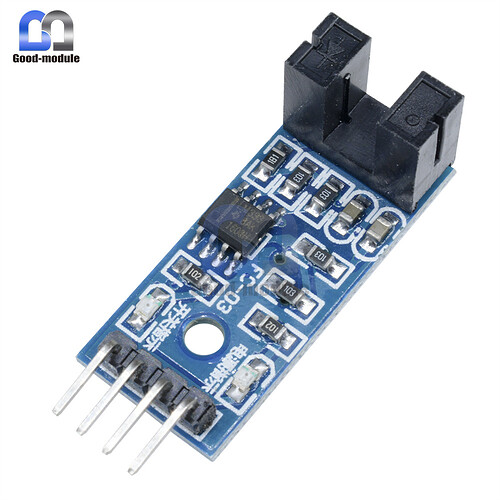I have built up a breadboard shaft turn counter to be used as limit switches on a small high torque DC motor driving a vacuum variable capacitor. The motor rotation is controlled with an DPDT ON-OFF-ON, for reverse polariation, and a momentary switch for "fine tuning". I have manually turned and counted the number of turns from the lower to the upper stops of the VVC. In practice, I will stop turning the shaft a couple of turns above the the lower and below the upper stops to avoid damaging the VVC. The LM 393's are placed back to back, wired separately as A and B to digital pins.The shaft has a small disc configured with 4 segments the width of both A&B IRs at the cardinal points of the disc and 4 slots the same width in between. This gives 4 readings each 360 degree cycle Each time A and B are LOW a counter should advance by one for clockwise or subtracted for counter clockwise.This part isn't working. I'm using a slow 2 RPM DC motor I have on hand, because it has enough torque to turn the Russian VVC. I think I might need to eliminate multiple counts I might get due to the slow speed, or maybe, this is not a problem I'm not certain. When I change the DPDT switch, the motor reverses direction, but coding doesn't sense the counter clockwise movement. I'm probably doing something stupid and need an experienced eye to find coding mistakes. Some serial monitor printout is below. Thanks.
#include <SPI.h>
#include <Wire.h>
#include <Adafruit_GFX.h>
#include <Adafruit_SSD1306.h>
#define OLED_RESET 4
Adafruit_SSD1306 display(OLED_RESET);
#define NUMFLAKES 10
#define XPOS 0
#define YPOS 1
#define DELTAY 2
// this is the Width and Height of Display which is 128 xy 32
#define LOGO16_GLCD_HEIGHT 32
#define LOGO16_GLCD_WIDTH 128
#if (SSD1306_LCDHEIGHT != 32)
#error("Height incorrect, please fix Adafruit_SSD1306.h!");
#endif
#define moduleA 10 // Output from IR module A
#define moduleB 11 // Output from IR module B
// variables
const int runButton = 12;
int buttonState = LOW;
int modAstate;
int modBstate;
int lastAstate;
int lastBstate;
bool firstTimeFlag = false;
bool cwFlag;
bool ccwFlag;
double pulses = 0;
void setup()
{
Serial.begin(9600);
display.begin(SSD1306_SWITCHCAPVCC, 0x3C); // initialize with the I2C addr 0x3C (for the 128x32)
display.display();
delay(2000);
// Clear the buffer.
display.clearDisplay();
display.setTextColor(WHITE);
display.drawLine(1, 37, 100, 37, WHITE);
display.drawRect(1, 1, 126, 31, WHITE);
display.display();
pinMode(moduleA, INPUT);
pinMode(moduleB, INPUT);
pinMode(runButton, INPUT);
}
void loop()
{
buttonState = digitalRead(runButton);
Serial.print("buttonState = ");
Serial.println(buttonState);
if (buttonState == HIGH)
{
modAstate = digitalRead(moduleA);
Serial.print("modAstate = ");
Serial.println(modAstate);
modBstate = digitalRead(moduleB);
Serial.print("modBstate = ");
Serial.println(modBstate);
delay(4000);
}
if (firstTimeFlag == false)
{
Serial.print("firstTimeFlag = ");
Serial.println(firstTimeFlag);
firstTimeFlag = true; // Turn ON firstTimeFlag
Serial.print("firstTimeFlag = ");
Serial.println(firstTimeFlag);
lastAstate = modAstate; // Initialize lastAstate
lastBstate = modBstate; // Initialize lastBstate
}
whatRotation(); // Determine Rotation
if (cwFlag == true)
{
Serial.print("cwFlag = ");
Serial.println(cwFlag);
clockWise();
}
else if (ccwFlag == true)
{
Serial.print("ccwFlag = ");
Serial.println(ccwFlag);
counterclockWise();
}
else
{
Serial.println("NO BUTTON ");
delay(2000);
}
}
void whatRotation()
{ // Clockwise
Serial.println(" At whatRotation ");
if (modAstate == HIGH && modBstate == LOW // Read moduleA first
|| modAstate == HIGH && modBstate == HIGH
|| modAstate == LOW && modBstate == HIGH)
{
Serial.print("lastAstate = ");
Serial.println(lastAstate);
Serial.print("lastBstate = ");
Serial.println(lastBstate);
modAstate = digitalRead(moduleA);
Serial.print("modAstate_1 = ");
Serial.println(modAstate);
modBstate = digitalRead(moduleB);
Serial.print("modBstate_1 = ");
Serial.println(modBstate);
cwFlag = true;
}
// Counter Clockwise
else if (modBstate == HIGH && modAstate == LOW // Polarity changed
|| modBstate == HIGH && modAstate == HIGH // Read moduleB first
|| modBstate == LOW && modAstate == HIGH)
{
modBstate = digitalRead(moduleB);
Serial.print("modBstate_1 = ");
Serial.println(modBstate);
modAstate = digitalRead(moduleA);
Serial.print("modAstate_1 = ");
Serial.println(modAstate);
ccwFlag = true;
}
}
void clockWise()
{
Serial.println("At CLOCKWISE");
if (modAstate == LOW && modBstate == LOW)
if( modAstate != lastAstate && modBstate != lastBstate) // Dont't add to pulses until change of state)
{
Serial.print("lastAstate = ");
Serial.println(lastAstate);
Serial.print("lastBstate = ");
Serial.println(lastBstate);
Serial.println("At ++.25");
pulses += .25; // Add 1/4 turn
display.clearDisplay();
display.setTextSize(1);
display.setCursor(4, 3);
display.print("TURNS = ");
Serial.println("TURNS ++ ");
display.setTextSize(1);
display.setCursor(66, 2);
display.print(pulses);
Serial.println(pulses);
lastAstate = modAstate;
lastBstate = modBstate;
display.display();
delay(4000);
}
}
void counterclockWise()
{ // Counter Clockwise
Serial.println("At COUNTR CLOCKWISE");
if (modBstate == LOW && modAstate == LOW
&& modBstate != lastBstate && modAstate != lastAstate) // Dont't lower pulses until change of state
{
Serial.print("lastBstate = ");
Serial.println(lastBstate);
Serial.print("lastAstate = ");
Serial.println(lastAstate);
Serial.println("At --.25");
pulses -= .25; // Subtract 1/4 turn
display.clearDisplay();
display.setTextSize(1);
display.setCursor(4, 3);
display.print("TURNS = ");
Serial.println("TURNS -- ");
display.setTextSize(1);
display.setCursor(66, 2);
display.print(pulses);
Serial.println(pulses);
display.display();
lastBstate = modBstate;
lastAstate = modAstate;
delay(4000);
}
}
buttonState = 0
firstTimeFlag = 0
firstTimeFlag = 1
At whatRotation
NO BUTTON
buttonState = 0
At whatRotation
NO BUTTON
buttonState = 0
At whatRotation
NO BUTTON
buttonState = 1
modAstate = 0
modBstate = 1
At whatRotation
lastAstate = 0
lastBstate = 0
modAstate_1 = 1
modBstate_1 = 1
cwFlag = 1
At CLOCKWISE
buttonState = 1
modAstate = 1
modBstate = 1
At whatRotation
lastAstate = 0
lastBstate = 0
modAstate_1 = 1
modBstate_1 = 0
cwFlag = 1
At CLOCKWISE
buttonState = 1
modAstate = 1
modBstate = 0
At whatRotation
lastAstate = 0
lastBstate = 0
modAstate_1 = 0
modBstate_1 = 1
cwFlag = 1
At CLOCKWISE
buttonState = 1
modAstate = 0
modBstate = 1
